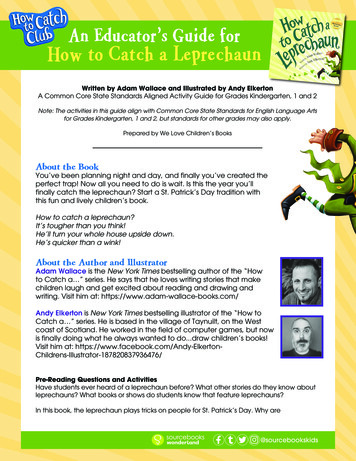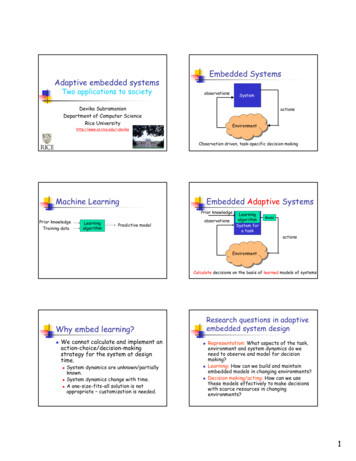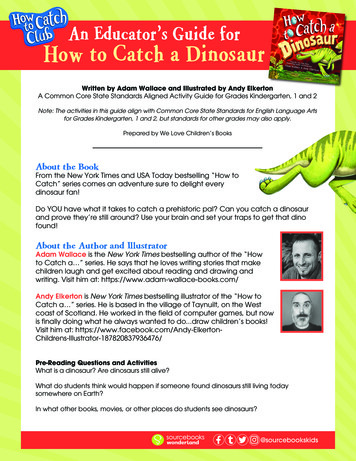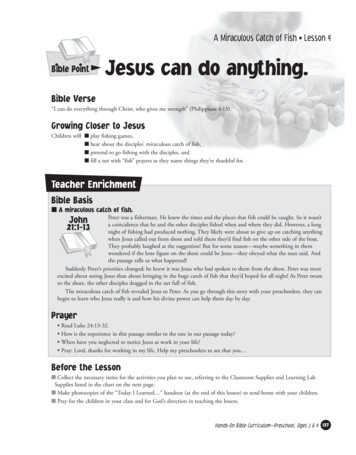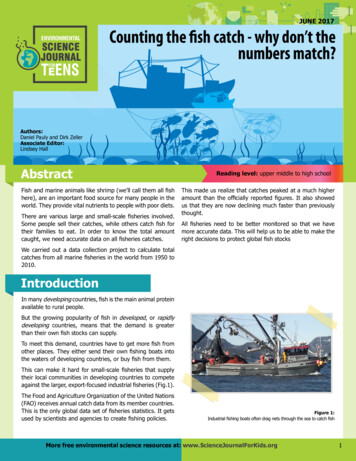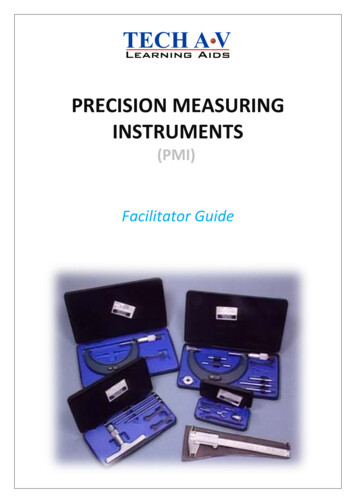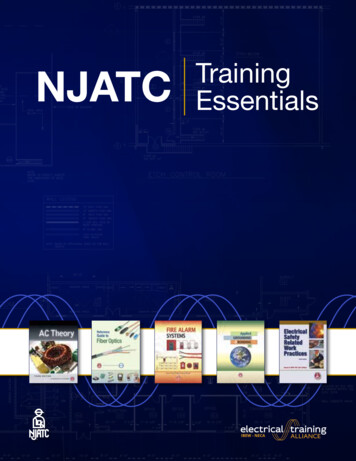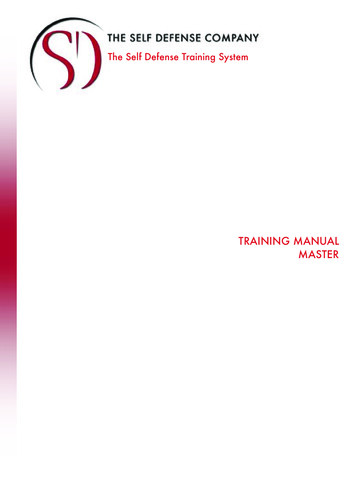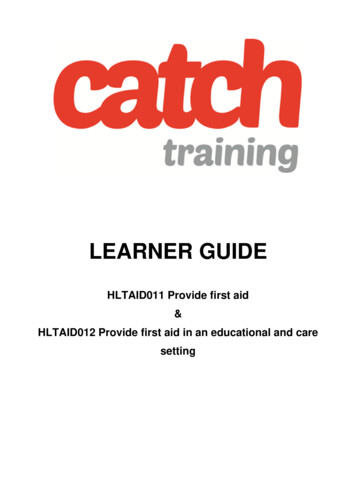
Transcription
LEARNER GUIDEHLTAID011 Provide first aid&HLTAID012 Provide first aid in an educational and caresetting
Table of ContentsReview Log. 6Module Basis . 61.1 Introduction . 71.2 First Aid and Emergencies . 81.2.1 What is an Emergency? . 81.3 Legal, Workplace and Community Factors . 91.3.1 Duty of Care. 91.3.1.1 WHS Legislation and Guidelines . 101.3.2 Consent . 111.3.2.1 Showing Respect . 111.3.2.2 Negligence and Litigation . 111.3.3 Privacy and Confidentiality . 121.3.4 Your First Aid Skills and Limits . 121.3.5 Stress Management and Debriefing . 131.4 Risk Management . 141.4.1 Identify Hazards . 141.4.2 Conduct a Dynamic Risk Assessment . 151.4.3 Minimise Risk . 151.4.4 Isolate Hazards . 161.5 Principles of First Aid . 171.5.1 Basic Anatomy and Physiology . 18/191.6 Assess the Scene and Casualty . 201.6.1 Initial Assessment . 201.6.1.1 Survey the Scene . 211.6.1.2 Primary Survey . 21/221.6.1.3 Secondary Survey . 231.6.2 Triage . 241.7 Reassure the Casualty. 251.7.1 Make the Casualty Comfortable . 26/271.8 Maintain Hygiene . 281.9 Use Manual Handling Techniques . 291.9.1 Emergency Moves . 291.9.1.1 One Person . 30/311.9.1.2 Two or More People. 321.9.2 Planned Moves . 321.9.2.1 Two-Handed Seat Carry . 331.9.2.2 Four-Handed Seat Carry. 341.9.2.3 Chair Lift . 351.9.2.4 Wheelchair Lift . 351.9.2.5 Blanket Lift . 361.9.2.6 Stretchers . 372.1 Provide First Aid Management. 392.1.1 Correctly Operate First Aid Equipment . 402.2 DRS ABCD Action Plan . 412.2.1 D – Danger . 412.2.2 R – Response . 422.2.3 S – Send for Help. 432.2.4 A – Airway. 442.2.4.1 The Recovery Position . 44Catch Training – Version 6 HLTAID011 & HLTAID012 First AidLearner GuidePage 2
2.2.5 B – Breathing . 452.2.6 C – Compressions/CPR . 45-472.2.6.1 Rescue Breaths . 482.2.6.2 The Chain of Survival. 492.2.6.3 Stopping CPR . 492.2.7 D – Defibrillator . 50/512.3 Shock . 522.4 Chest Pain . 532.4.1 Sudden Cardiac Arrest . 53/542.4.2 Heart Attack . 54/552.4.3 Angina . 552.4.4 Congestive Heart Failure . 562.4.5 Drowning . 572.5 Skeletal Injuries . 582.5.1 Head, Neck and Spinal Injuries . 58/592.5.2 Fractures and Breaks . 602.5.3 Dislocations . 612.5.4 Immobilisation/Slinging . 612.5.4.1 Common Body Splint/Slinging Techniques . 622.6 Altered Consciousness . 632.6.1 Head Injuries. 642.6.1.1 Concussion . 652.6.1.2 Cerebral Compressions . 662.6.2 Stroke . 672.6.3 Seizures . 682.6.3.1 Febrile Convulsions . 692.6.4 Diabetic Emergencies . 702.6.4.1 Low Blood Sugar/Hypoglycaemia . 702.6.4.2 High Blood Sugar/Hyperglycaemia . 712.6.5 Fainting . 722.7 Respiratory Distress/Conditions . 732.7.1 Asthma Attack . 73/742.7.2 Severe Allergic Reactions . 752.7.3 Hyperventilation . 762.7.4 Choking . 77Catch Training – Version 6 HLTAID011 & HLTAID012 First AidLearner GuidePage 3
2.8 Bleeding, Wounds and Injuries . 782.8.1 Bleeding . 782.8.1.1 Internal Bleeding . 792.8.1.2 External Bleeding/Haemorrhaging . 80/812.8.2 Wounds and Injuries . 822.8.2.1 Nose Wounds . 832.8.2.2 Abdominal Injuries . 832.8.2.3 Crush Injuries. 842.8.2.4 Scalp Wounds. 852.8.2.5 Eye Injuries . 862.8.2.6 Ear Injuries . 872.8.2.7 Needle Stick Injuries . 882.8.2.8 Sprains and Strains . 89-912.9 Burns . 922.9.1 Heat Burns . 922.9.2 Chemical Burns. 932.9.3 Electrical Burns/Shock . 942.10 Environmental Impact. 952.10.1 Hypothermia . 952.10.2 Hyperthermia . 962.10.2.1 Heat Exhaustion . 972.10.2.2 Heat Stroke . 982.11 Envenomation . 992.11.1 Insect Bites and Stings. 992.11.2 Spider Bites . 1002.11.2.1 Red-Back Spider . 1002.11.2.2 Funnel Web Spider . 1012.11.3 Snake Bite . 1022.11.4 Marine Bites and Stings . 1032.11.4.1 Bluebottle & Non-Box Jellyfish . 1032.11.4.2 Box Jellyfish . 1042.11.4.3 Blue-Ringed Octopus & Cone Shell . 1052.11.4.4 Stonefish, Bull Rout & Stingray . 1062.12 Poisons . 107-1092.12.1 Substance Misuse – Alcohol & Other Drugs . 110Review Log. 111Module Basis . 1123.1 Monitor and Respond to Casualty’s Condition . 1133.2 Finalise First Aid Treatment . 1143.2.1 Providing Assistance . 1143.2.2 Reporting Incident Details . 1153.2.2.1 Reporting to Supervisors . 1163.2.3 Maintaining Confidentiality . 1163.3 Evaluate Your Performance . 1173.3.1 Recognising Psychological impacts . 1173.3.2 Dealing With Stress . 1183.3.3 Debriefing and Self-Evaluation . 118Appendix A – First Aid/Incident Report Form . 19Appendix B – First Aid Treatment Self Evaluation Form . 120HLTAID012 Provide first aid in an educational an caresetting . .121-125Catch Training – Version 6 HLTAID011 & HLTAID012 First AidLearner GuidePage 4
Catch Training – Version 6 HLTAID011 & HLTAID012 First AidLearner GuidePage 5
Review LogVersion NumberVersion 5ReleasedNovember, 2013Version 6Date UpdatedDetails of UpdatesReleased April2021Including latest updates from ARC guidelines for CovidModule BasisThis module is based on the unit of competency HLTAID011 Provide First Aid:Element 1 – Respond in an emergency situation.1.1 Recognise an emergency situation.1.2 Identify, assess and manage immediate hazards to health and safety of self and others.1.3 Assess the casualty and recognise the need for first aid response.1.4 Assess the situation and seek assistance from emergency response services where required.Element 2 – Apply appropriate first aid procedures.2.3 Display respectful behaviour towards casualty.2.4 Obtain consent from casualty where possible.2.5 Use available resources and equipment to make the casualty as comfortable as possible.Catch Training – Version 6 HLTAID011 & HLTAID012 First AidLearner GuidePage 6
1.1 IntroductionThis training course is based on the unit of competency HLTAID011 Provide First Aid.This course describes the skills and knowledge required by a worker to provide a first aid response to a casualty in arange of situations including community and workplace settings.Catch Training – Version 6 HLTAID011 & HLTAID012 First AidLearner GuidePage 7
1.2 First Aid and EmergenciesThe basic principles and concepts of first aid are to:Relieve pain and suffering.Avoid further illness or injury or worsening of illness or injury.Protect individuals who are unconscious.Encourage recovery.Prevent or reduce disability.Save lives.Through First Aid training you will learn the skills you need to respond to a medical emergency so you can save lives andreduce pain and injury until qualified medical help takes over.1.2.1 WHAT IS AN EMERGENCY?An emergency is a situation where there is an immediate risk to health, life,property or environment and urgent action is needed to try to stop the situationfrom getting worse.A situation can only be defined as an emergency if one or more of the followingare present:Immediate threat to life, health, property or environment.Loss of life, health detriments, property damage or environmentaldamage.A high probability of escalation to cause immediate danger to life,health, property or environment.It is important that you know and look out for signs of possible emergencies.Sometimes it can be hard to identify an emergency – using all your senses mayhelp. Signs may include unusual noises, sights, smells and behaviours such as:Alarms and sirens, moaning, crying or yelling and sounds of breakage,crashing or falling.Stalled or crashed vehicle, spilled medications and other items, aperson collapsed on the floor or who seems to be confused, in pain orhaving trouble breathing.Different or stronger smells than usual (be very careful in thesesituations as any fumes may be poisonous).Catch Training – Version 6 HLTAID011 & HLTAID012 First AidLearner GuidePage 8
1.3 Legal, Workplace and Community FactorsAs someone who is trained in first aid there are a number of legal, workplaceand community factors you need to think about.The information here is meant as a guide – always make sure that you arefamiliar with the particular requirements of your state/territory andorganisation.Being trained in first aid doesn’t mean you can be forced to attempt a firstaid rescue in an emergency situation. You can observe or walk away fromthe scene, though this is not encouraged. You should always do what youcan to help someone in need. You should also remember to keep yourselfsafe and well.Legal, workplace and community factors you need to consider include:Duty of care requirements.Consent.Respectful behaviour towards a casualty.Privacy and confidentiality requirements.Your own skills and limitations.The need for stress-management techniques and available supportfollowing an emergency situation.The importance of debriefing.1.3.1 DUTY OF CAREOnce you start providing first aid the law says you must continue until:Vital signs return.Paramedic assistance arrives from emergency response services.Exhaustion makes it impossible to continue.Authorised personnel declare the casualty as officially deceased.This legal obligation to care is known as ‘duty of care’.Catch Training – Version 6 HLTAID011 & HLTAID012 First AidLearner GuidePage 9
Duty of care means that you must take reasonable steps to ensure your actions don’tknowingly cause harm to another individual.In a first aid situation you don’t legally have to provide treatment, unless you have aprevious duty of care to the injured person.Some examples of where a duty of care to provide first aid exists include cases where:You are a worker who is trained, qualified and designated as a first aid officerin a company and you have a duty of care to provide first aid to workers in thecompany.You are responsible for the person injured.You are an official first aid volunteer at a public event.You have started giving first aid in an emergency.In a situation where you have started first aid, under duty of care you can’t thenstop unless a medical practitioner or a person with better qualifications takesover. Your duty of care is to do everything reasonable given the situation.If you are unable to hand the casualty over to a medical practitioner, you shouldalways advise the individual to seek professional medical assistance/advice.In the workplace duty of care is also affected by Work Health & Safety (WHS)legislation.1.3.1.1 WHS Legislation and GuidelinesWHS legislation are the laws and guidelines designed help keep your workplace safe.It is important that you are familiar with the WHS laws that exist in your state orterritory.WHS legislation and regulations outline the responsibilities of a person conducting abusiness or undertaking (PCBUs) to provide first aid facilities and workers trained infirst aid. The regulations may also detail the requirements of first aid kits and facilitiesbased on the size of the organisation and the type of work environment.WHS guidelines for preventing accidents in the workplace should be found in thecompany’s polices and standard operating procedures. It should have procedures onhow to deal with a workplace accident.It may include instructions on how to use Personal Protective Equipment(PPE), which can prevent infection spreading. If in doubt about following anyof the procedures and guidelines contained in the company’s WHS manual talkto the WHS officer.WHS guidelines must be followed at all times to ensure the safety of allworkers.Catch Training – Version 6 HLTAID011 & HLTAID012 First AidLearner GuidePage 10
1.3.2 CONSENTIf you decide to go ahead with first aid, you must try to get consent from the casualty,and stop if they ask you to.If the person doesn’t give consent and you touch them or they think you will touchthem you could be charged with assault or battery.You may not always be able to get consent from an injured person, as they may beunable to communicate and/or unconscious.In these cases the law assumes that the person would have consented if they hadbeen able to, but only if their life and/or future health was in danger.Where the injured person is a minor (child) you should get consent from aparent or guardian.If they are not available it can be assumed that consent for first aid would begiven.If you can’t be sure that the injured individual has consented to receive first aidyou may go ahead with the treatment if there is no outright refusal ofassistance.If the casualty is well enough to speak, ask them if it is all right if you touchthem or move them. Think about how you would like to be treated if you werehurt and scared, and treat the casualty the same way.1.3.2.1 Showing RespectIt is important to be aware that individuals may have differing views and beliefsregarding receiving medical or first aid treatment. These may relate to cultural,religious or personal beliefs and customs.Your life saving skills should be applied to the casualty in a way that doesn’t force firstaid procedures and respects the individual’s beliefs. You should follow the guidelinesfor consent with every individual.Also check the casualty for medical identification tags such as a bracelet or necklace.These will give you information like the name of the casualty, emergency contact,medical illnesses, allergies, and even what medical treatment they would refuse.1.3.2.2 Negligence and LitigationMost casualties are grateful for receiving first aid, but sometimes a person mighttake their rescuer to court for negligence.This should only happen if you are not trained, qualified or authorised to carryout first aid.The threat of negligence should not stop you from trying to help. The GoodSamaritans (or Civil Liability) Act aims to protect anyone who is trained toperform first aid from being sued on the grounds of negligence if somethinggoes wrong and the casualty ends up with injuries caused by the actions of thefirst aider.Catch Training – Version 6 HLTAID011 & HLTAID012 First AidLearner GuidePage 11
1.3.3 PRIVACY AND CONFIDENTIALITYIt is important to keep records of emergencies and injuries, including what happenedand how it was addressed.Recording keeping and reporting requirements can vary between states andterritories, industries and organisations.If you are acting as a first aid officer in your workplace make sure you follow thespecific recording guidelines and procedures.Records should be made and kept for every workplace first aid incident, with copiesprovided to the PCBU.If providing first aid outside of the workplace you should make a record of the event,or at least keep notes about the first aid you gave.Records should be clear and concise as they may be used as a legal document incourt. Make sure that any first aid records are accurate, factual and only includeyour observations and actions, not your opinions.You should also be aware of privacy and confidentiality legislation. This protectsmedical data from being circulated to the general public and ensures it is onlyhandled by authorised workers and on a ‘need to know’ basis.Each organisation will have policies and procedures for safeguarding sensitivemedical information, including first aid details. Remember, if any patient informationis leaked there are serious consequences and legal action could be taken.1.3.4 YOUR FIRST AID SKILLS AND LIMITSParamedics have advanced skills in first aid and when they arrive to treat the casualtythey can apply advanced life support procedures that they are qualified to administer.As a first aider you are not expected to be an expert.Your role is about responding promptly, being able to prioritise and be proactive inapplying the principles of first aid management.Catch Training – Version 6 HLTAID011 & HLTAID012 First AidLearner GuidePage 12
Be aware of your own personal limitations including:It is also a good idea to keep trying to improve your first aid skills.Your organisation might provide training so you can keep your skills up to date. Youcould also do your own reading and research.There will always be something that you can learn and therefore be a more effectivefirst aider.1.3.5 STRESS MANAGEMENT AND DEBRIEFI
Catch Training - Version 6 HLTAID011 & HLTAID012 First Aid Learner Guide Page 10 Duty of care means that you must take reasonable steps to ensure your actions don't knowingly cause harm to another individual. In a first aid situation you don't legally have to provide treatment, unless you have a previous duty of care to the injured person.
